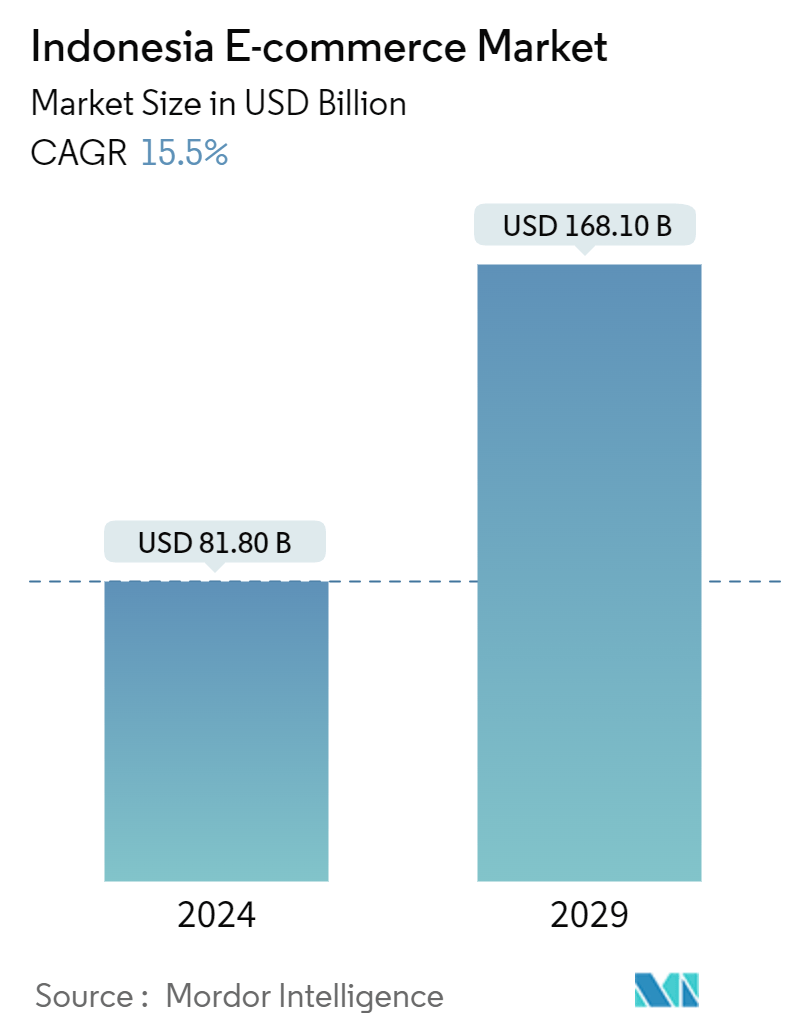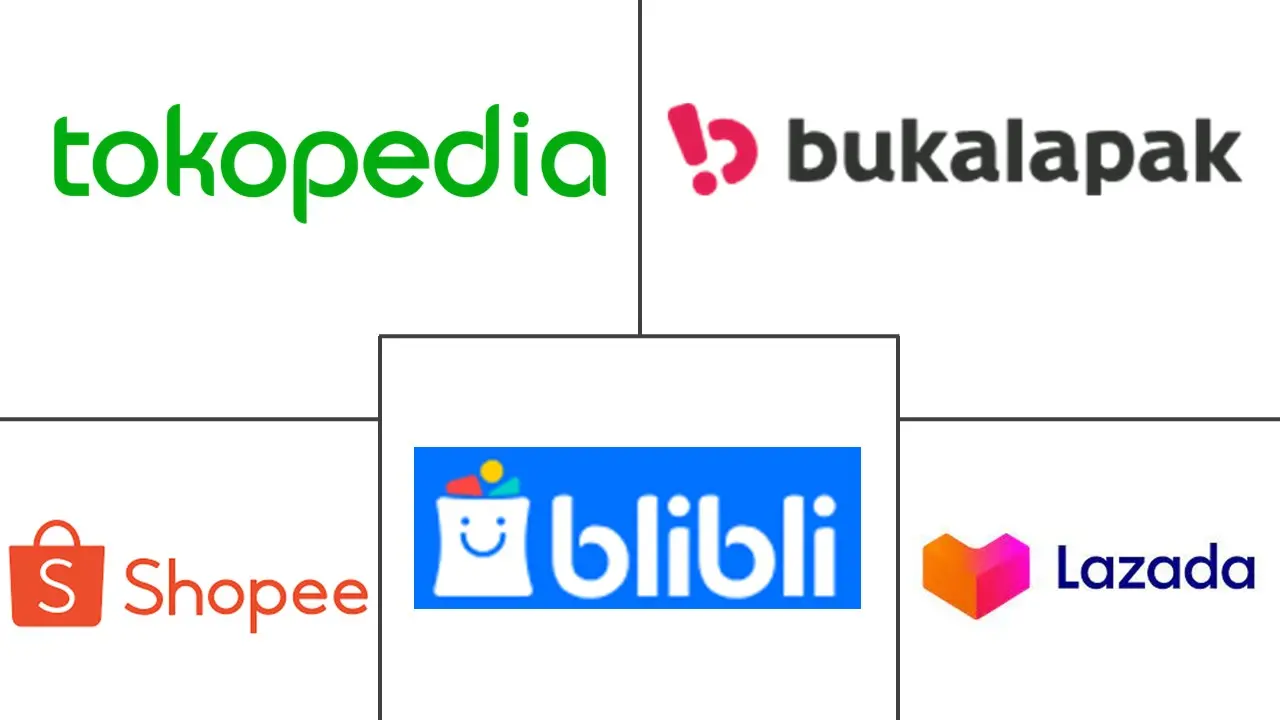Market Size of Indonesia E-commerce Industry

| Study Period | 2019 - 2029 |
| Base Year For Estimation | 2023 |
| Market Size (2024) | USD 81.80 Billion |
| Market Size (2029) | USD 168.10 Billion |
| CAGR (2024 - 2029) | 15.50 % |
| Market Concentration | Medium |
Major Players
*Disclaimer: Major Players sorted in no particular order |
Need a report that reflects how COVID-19 has impacted this market and its growth?
Indonesia Ecommerce Market Analysis
The Indonesia E-commerce Market size is estimated at USD 81.80 billion in 2024, and is expected to reach USD 168.10 billion by 2029, growing at a CAGR of 15.5% during the forecast period (2024-2029).
The E-commerce market in Indonesia is driven by the growing fashion industry and internet and smartphone penetration, among others.
- A key driver of e-commerce growth in Indonesia is the convenience factor offered by online shopping and e-commerce platforms' continuous focus on improving customers' overall shopping experience on online platforms. Shoppers nationwide are now turning to e-commerce platforms to fulfill their diverse needs, from electronics and clothing to groceries. Such factors have led to substantial growth in online shoppers across the country over the past few years.
- In addition, high smartphone usage and internet penetration stimulate the growth of the e-commerce market in the country. The growing internet usage at affordable rates and the rise of smartphones has led to more accessible access to online shopping in the country. In addition, high mobile penetration in Indonesia makes it more convenient for consumers to shop for a wide variety of products online, thus positively influencing the market's growth.
- Moreover, governments and central banks are eagerly facilitating digital payment systems in the country as these payments are more efficient and transparent. The proliferation of digital payments in the country is further analyzed to assist in the growth of the country's e-commerce market.
- Cyberattacks or data breaches in an e-commerce enterprise may lead to a reduction in the trust of customers in online shopping and can negatively impact the growth of the e-commerce market in Indonesia. E-commerce players like Tokopedia, one of Indonesia's largest e-commerce platforms, have suffered significant data breaches. Such incidents also attract regulatory scrutiny and may lead to stricter data protection laws, thus further hampering the growth of the e-commerce market in Indonesia.
- With COVID-19, the e-commerce market in the country has witnessed a significant expansion in the past few years, primarily supported by the high internet and smartphone penetration, growing young and tech-savvy population, changing consumer purchasing behavior, and expanding digital economy coupled with the significant presence of major e-commerce vendors offering the variety, convenience, and competitive pricing for online shopping. In addition, the Indonesian government's proactive role in fostering e-commerce in the digital economy has further fuelled the growth of the country's e-commerce market.
Indonesia Ecommerce Industry Segmentation
The Indonesian e-commerce market is defined based on the GMV generated by B2B and B2C e-commerce across the country. The analysis is based on the market insights captured through secondary research and the primaries. The market also covers the major factors impacting the market's growth in terms of drivers and restraints.
The study also tracks important market metrics, underlying growth influencers, and significant industry vendors, providing support for market estimates and growth rates in Indonesia throughout the anticipated period. Indonesia's e-commerce market is segmented by B2C ECommerce (beauty and personal care, consumer electronics, fashion and apparel, food and beverage, furniture and home, and other B2C applications (toys, DIY, media, etc.))) and B2B e-commerce. The market sizes and forecasts are provided in terms of value in USD for all the above segments.
| By B2C Ecommerce | ||||||||
|
Indonesia E-commerce Market Size Summary
The Indonesia E-commerce market is projected to experience substantial growth in the coming years. This expansion is driven by the rise of e-commerce businesses and the significant growth of the digital economy, leading to increased online retailing. Numerous e-commerce market players are extending their operations in Indonesia to capitalize on the growing demand. Factors such as smartphone and internet penetration are key drivers of e-commerce growth in the region. The Indonesian government is also encouraging the development of e-commerce in alignment with the President's vision for the digital economy's transition. The e-commerce market in Indonesia is attracting investment from international players due to the high demand from online consumers. The market is regulated by several laws and regulations, with foreign e-commerce platforms required to establish a representative office in Indonesia. The COVID-19 pandemic has further boosted the e-commerce market, as social distancing measures have led to increased online shopping for essential services. The rise of e-commerce has also been facilitated by electronic payment systems, which have reduced transaction costs and made commercial processing more efficient.
Explore MoreIndonesia E-commerce Market Size - Table of Contents
-
1. MARKET INSIGHTS
-
1.1 Market Overview
-
1.2 Industry Attractiveness-Porter's Five Forces Analysis
-
1.2.1 Bargaining Power of Suppliers
-
1.2.2 Bargaining Power of Buyers
-
1.2.3 Threat of New Entrants
-
1.2.4 Threat of Substitute Products
-
1.2.5 Intensity of Competitive Rivalry
-
-
1.3 Key Market Trends and Share of E-commerce of Total Retail Sector
-
1.4 Impact of COVID-19 on the E-commerce Sales
-
-
2. MARKET SEGMENTATION
-
2.1 By B2C Ecommerce
-
2.1.1 Market Segmentation - by B2C Application
-
2.1.1.1 Beauty and Personal Care
-
2.1.1.2 Consumer Electronics
-
2.1.1.3 Fashion and Apparel
-
2.1.1.4 Food and Beverage
-
2.1.1.5 Furniture and Home
-
2.1.1.6 Other B2C Applications (Toys, DIY, Media, Etc.)
-
-
-
2.2 By B2B E-commerce
-
Indonesia E-commerce Market Size FAQs
How big is the Indonesia E-commerce Market?
The Indonesia E-commerce Market size is expected to reach USD 81.80 billion in 2024 and grow at a CAGR of 15.5% to reach USD 168.10 billion by 2029.
What is the current Indonesia E-commerce Market size?
In 2024, the Indonesia E-commerce Market size is expected to reach USD 81.80 billion.
